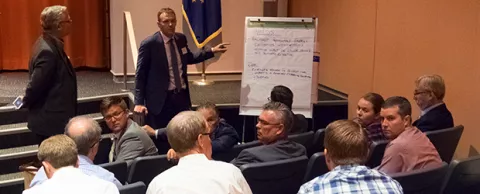
What comes first: the technology or the people? We were in Indianapolis this week for our third Readiness Challenge Grant Workshop — and the answer there is clearly the public.
Indianapolis was one of five cities to win our first series of grants and more than 100 people attended its workshop, looking for ways to truly improve the lives of the city’s residents. Mayor Joe Hogsett called it “a fascinating day full of big ideas and big thoughts.”
From digital services that save citizens time to data that can make people safer and the environment cleaner, here’s what Indianapolis has been up to — and what’s coming next. — Kevin Ebi
Indianapolis has been a hotbed for technology investment. And while the city has put it to great use — you’ll never have to waste time looking for a parking space — it’s ready to do even more.
“We’ve seen such an impressive investment in Indianapolis from a technology perspective over the past 10 years that it has really revolutionized where we are,” said Ken Clark, chief information officer of Indianapolis and the Marion County Information Services Agency. “And I think there’s a lot of excitement about what the city can do to enable that growth and be a good steward of that technology.”
Already, every street parking space has a sensor in it. Drivers wanting a night on the town don’t waste any of that trying to find a place to park. But the city isn’t stopping there.
Saving people time, anticipating needs
Through its Shift Indy initiative, Indianapolis has been looking for ways to make people’s lives easier. Completely rethinking how its website works has been a big part of that shift.
“It would have been easy to just re-skin the website,” Clark said. “But our discussions were about, ‘Let’s take a look at the bigger picture here. What can we do? Technology has changed so significantly over the past 10 years, so let’s take advantage of that.’”
So far, it has redesigned the way that people can apply for a mortgage tax deduction. The process used to involve paper forms and a week of effort. Now the application can be completed online in less time than it takes for a pizza to be delivered.
Indianapolis also closely monitors the services that people search for online. It uses people’s needs to decide what to focus on next.
How data can help
Indianapolis’s police department provides a valuable example of how data can make a difference — providing develop smart strategies for using it. The city has been working to use data to truly understand why people get into trouble and to use that knowledge to direct them to resources that can help.
“Instead of deploying a resource 10 times for a small narcotics arrest or an overdose, we actually started looking at the market, the addictions, the addictions counseling and medical treatment that was available, and how we could get it to our residents to address the root cause,” said Chad Knecht, deputy chief of operations for the Indianapolis Metropolitan Police Department.
But you can’t rely only on data. You have to talk to people too. He said the police department went through a period where it focused almost exclusively on data and ended up knowing less.
“It was very sterile and dry and that alienated us from many of the communities we serve and protect,” Knecht said. “We were so focused on the numbers that we weren’t getting the intelligence from everyone who lives and works in those communities.”
What’s next?
Indianapolis plans to be carbon neutral by 2050 and sees data as a valuable tool that can help it get there. Participants at the workshop suggested that the city use data to develop true benchmarks of the amount of emissions buildings are causing and then design strategies to make them more environmentally friendly. They also suggested centralizing the management of the city’s buildings to make it easier to manage them to the environmental targets and track progress.
Other suggestions included conducting a citywide inventory of data to eliminate duplicate sources and fill in gaps and developing an app to let police and firefighters quickly refer people they encounter who need social and economic assistance to resources that can help.



